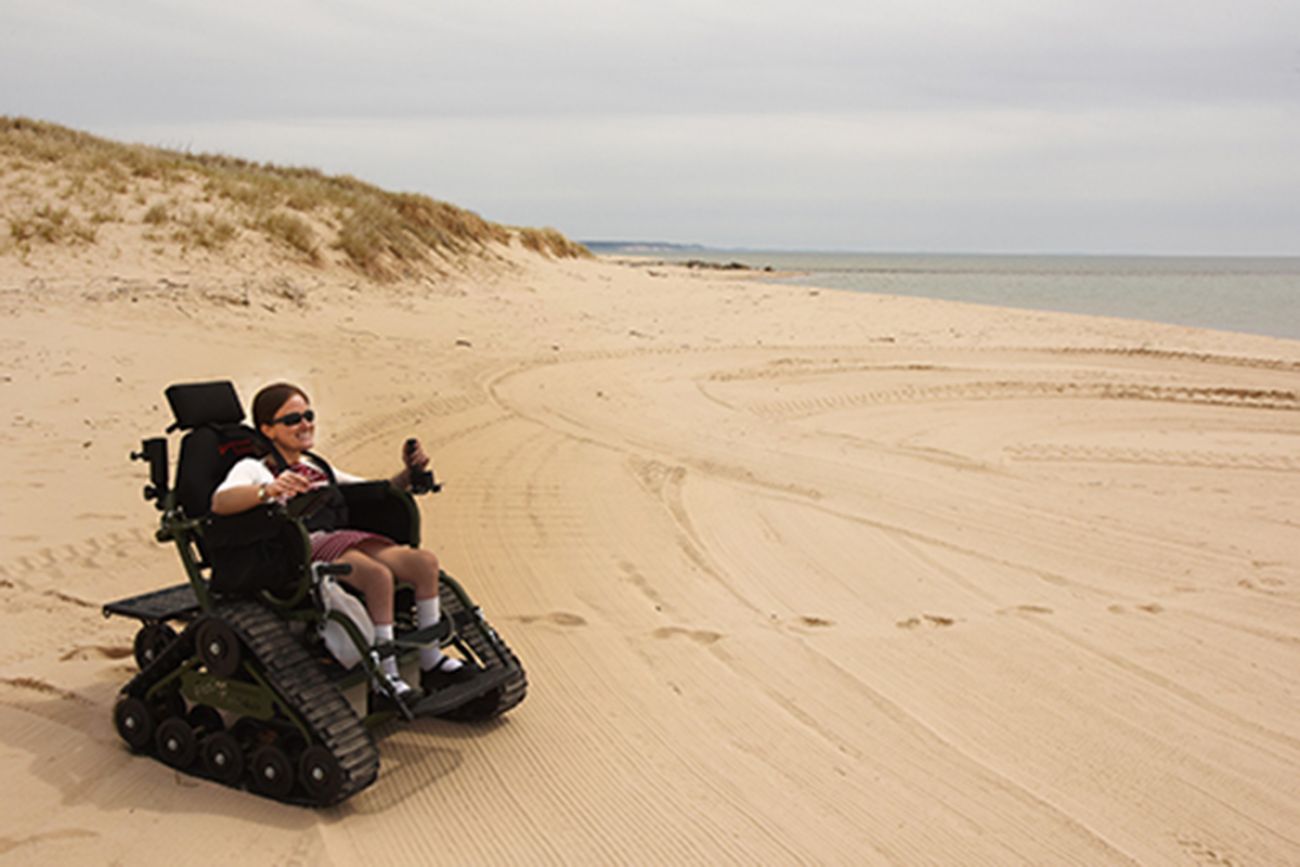Michigan parks, beaches are improving access to visitors with disabilities


In 1992, Cynthia Burkhour was taking her 12-year-old daughter Erin on a stroll across a zigzag bridge at Hager Park in Ottawa County when Erin’s wheelchair got stuck while turning a corner. Erin had suffered a stroke four months earlier that left her paralyzed on one side and with a language disorder, forcing her into a wheelchair and facing the harsh realities of large swaths of the outdoors being widely inaccessible.
“I hadn't figured out that it wasn't accessible until I got her wheelchair stuck on it,” Cynthia Burkhour said. “When your kid looks at you and goes, ‘really you thought this was accessible?’ … I felt pretty dumb.”
Related:
- How Michigan state parks will spend a $250 million COVID windfall
- Drownings are up across the Great Lakes. Michigan officials urge water safety
- See where you can borrow free camping gear in Michigan
Fast forward 30 years, and Michigan has made large strides to make parks like those Erin went to more accessible for those with disabilities. Even after Erin’s incident, Hager Park replaced all of its bridges to be more accessible.
Across the state there are 28 accessible beach parks, 31 accessible fishing spots and 34 accessible scenic viewpoints and trails.
According to the Center for Disease Control and Prevention, about 2.3 million Michiganders have some kind of disability. About 12 percent of adults in Michigan – one in eight – have a disability impacting their mobility.
Last year, Gov. Gretchen Whitmer announced a $250 million investment to update state parks, including updates to make parks more accessible, including at Tahquamenon Fall State Park in the Upper Peninsula.
That state investment, plus donations to a fundraising campaign, are paying for improvements that range from wheelchair accessible trails and kayak launches, to off-road electric wheelchairs that give the disabled access to beaches.
There are about 400 track chairs now throughout Michigan, according to Bryan Wilkinson, a member of the Michigan Accessibility Advisory Council and owner of Michigan Trackchair. Track chairs are spread out across 11 parks in the state.
Wilkinson himself has benefitted from track chairs since he became paralyzed almost 22 years ago. He said track chairs have allowed him to remain connected to the outdoors.
“The track chair gave me the ability to be in nature independently,” Wilkinson said. “Which was a huge door opener…It is important to give people outlets.”
Patrick O’Hare, president of Friends of Ludington State Park, on the shore of Lake Michigan, said track chairs are giving those who are disabled “that sense of freedom” to explore and enjoy the park with everyone else.
“It’s an opportunity to provide a mobility opportunity to let people get out into the park,” O’Hare said. “Individuals that may never have been able to, or individuals that have had some medical condition that is now not allowing them to traverse the trails or get down to the beach … they're able to do so.”
Thomas Murphy, who has bilateral neuropathy, was the first to use a track chair at Ludington State Park in late May — traveling more than 10 hours from Columbia, Tennessee to use it. Murphy said the experience “was a real blast” and that track chairs would “really open up some avenues of enjoyment for lots of folks.
“For about the last 15 years, I have not been able to do anything like that,” Murphy said. “I was hoping to hear the ocean again or the waves again and it kind of fulfilled that dream right there.”
The state also has six state parks and recreation areas that have accessible kayak launches. These sites have a transfer bench and slide that enables participants to sit and slide into the kayak.
Jessica Stark, a recreational therapist at Interlochen State Park and a council member on the Accessibility Advisory Council, has assisted with efforts at Interlochen State Park to help those with disabilities enjoy kayaking.
Stark recalled helping one woman who was quadriplegic with getting into the kayak launch and the woman “yelling, ‘This is freedom!’”
“She's out of her wheelchair, she's on a level playing field with everybody else around her,” Stark said.
Tom Jones, another member of the council and president of Michigan Operation Freedom Outdoors, got involved with the council and efforts to boost accessibility after he returned from war with a traumatic brain injury and saw that helping those with disabilities gain access to the outdoors was an “opportunity to still serve.”
“Public land doesn't segregate…it’s still your public land,” Jones said. “I've flipped enough desks and [did] the work first and asked for permission later, so much that it's becoming a common practice to include the other-abled communities in these plans [to boost accessibility].”
Jones said that he hopes the future of accessibility efforts focus on “trying to get costs down” and implementing activities at more parks in the state so that Michiganders do not have to travel long distances to reach accessible outdoor activities.
Jones also said he would like to see “more inclusive, reserved opportunities for folks with health challenges that can't get out in the woods, in November in Michigan” when it is cold and harder for those with disabilities to navigate the lower temperatures and snow.
Ron Olson, parks chief for the Michigan Department of Natural Resources, said that the state’s efforts focus on incentivizing and implementing projects that go beyond the minimum standards set by the Americans with Disabilities Act when designing accessible spaces.
““We want everybody to have an inclusive [experience] so that people can enjoy the outdoors without having obstacles,” Olson said.
That work means there will be fewer experiences like Erin Burkhour suffered through in 1992, when her wheelchair was stuck on a non-accessible bridge.
“Every accessibility improvement that is made in recreation, or the outdoors, or the built environment, serves all of us,” Cynthia Burkhour, Erin’s mother, said. “[It’s] making the environment easier to use by everybody.”
Michigan Environment Watch
Michigan Environment Watch examines how public policy, industry, and other factors interact with the state’s trove of natural resources.
- See full coverage
- Subscribe
- Share tips and questions with Bridge environment reporter Kelly House
Michigan Environment Watch is made possible by generous financial support from:
Our generous Environment Watch underwriters encourage Bridge Michigan readers to also support civic journalism by becoming Bridge members. Please consider joining today.
See what new members are saying about why they donated to Bridge Michigan:
- “In order for this information to be accurate and unbiased it must be underwritten by its readers, not by special interests.” - Larry S.
- “Not many other media sources report on the topics Bridge does.” - Susan B.
- “Your journalism is outstanding and rare these days.” - Mark S.
If you want to ensure the future of nonpartisan, nonprofit Michigan journalism, please become a member today. You, too, will be asked why you donated and maybe we'll feature your quote next time!




